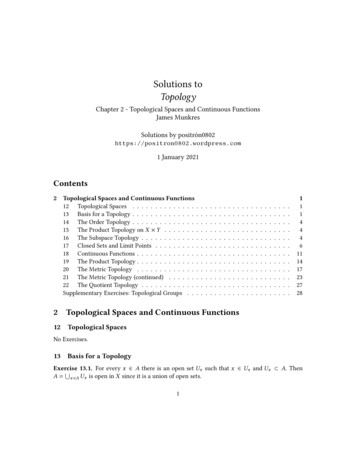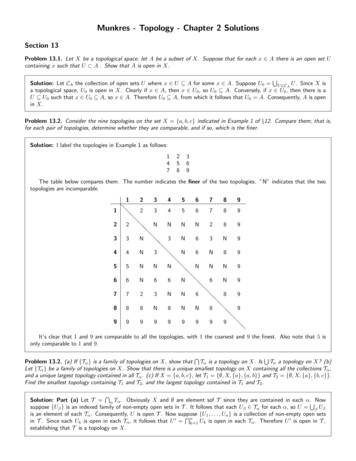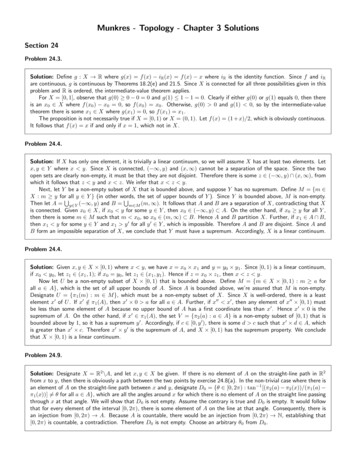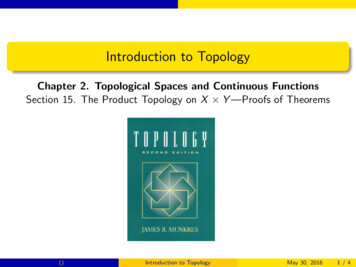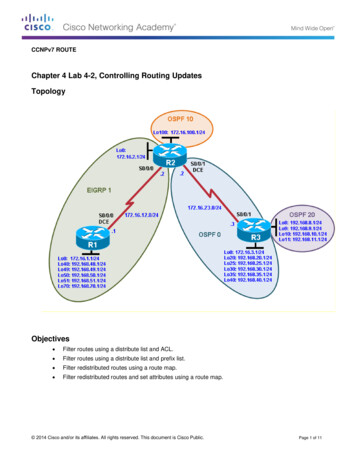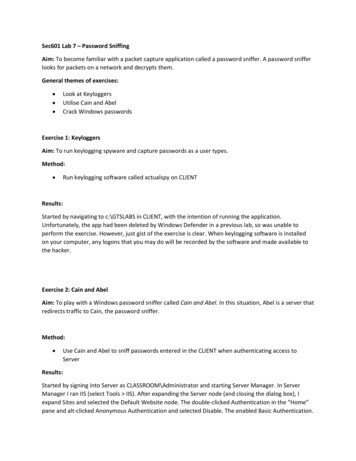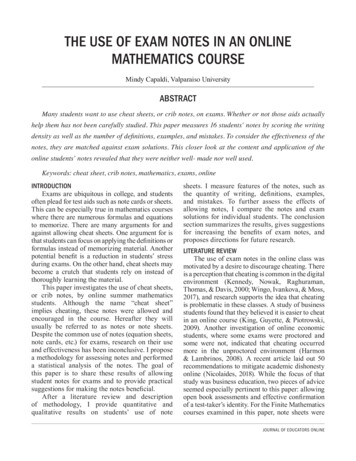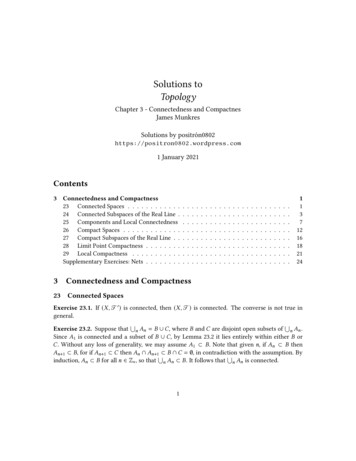
Transcription
Solutions toTopologyChapter 3 - Connectedness and CompactnesJames MunkresSolutions by positrón0802https://positron0802.wordpress.com1 January 2021Contents3 Connectedness and Compactness23 Connected Spaces . . . . . . . . . . . .24 Connected Subspaces of the Real Line .25 Components and Local Connectedness26 Compact Spaces . . . . . . . . . . . . .27 Compact Subspaces of the Real Line . .28 Limit Point Compactness . . . . . . . .29 Local Compactness . . . . . . . . . . .Supplementary Exercises: Nets . . . . . . . .3Connectedness and Compactness23Connected Spaces.11371216182124Exercise 23.1. If (𝑋, 𝒯 0) is connected, then (𝑋, 𝒯) is connected. The converse is not true ingeneral.ÐÐExercise 23.2. Suppose that 𝑛 𝐴𝑛 𝐵 𝐶, where 𝐵 and 𝐶 are disjoint open subsets of 𝑛 𝐴𝑛 .Since 𝐴1 is connected and a subset of 𝐵 𝐶, by Lemma 23.2 it lies entirely within either 𝐵 or𝐶. Without any loss of generality, we may assume 𝐴1 𝐵. Note that given 𝑛, if 𝐴𝑛 𝐵 then𝐴𝑛 1 𝐵, for if 𝐴𝑛 1 𝐶 then 𝐴𝑛 𝐴𝑛 1 𝐵 𝐶 , in contradiction with the assumption. ByÐÐinduction, 𝐴𝑛 𝐵 for all 𝑛 Z , so that 𝑛 𝐴𝑛 𝐵. It follows that 𝑛 𝐴𝑛 is connected.1
23Connected SpacesExercise 23.3. For each 𝛼 we have 𝐴 𝐴𝛼 , so each 𝐴 𝐴𝛼 is connected by Theorem 23.3.In turn {𝐴 𝐴𝛼 }𝛼 is a collection of connected spaces that have a point in common (namely anyÐÐpoint in 𝐴), so 𝛼 (𝐴 𝐴𝛼 ) 𝐴 ( 𝛼 𝐴𝛼 ) is connected by Theorem 23.3.Exercise 23.4. Suppose that 𝐴 is a non-empty subset of 𝑋 that is both open and closed, i.e., 𝐴and 𝑋 \ 𝐴 are finite or all of 𝑋 . Since 𝐴 is non-empty, 𝑋 \ 𝐴 is finite. Thus 𝐴 cannot be finite as𝑋 \ 𝐴 is infinite, so 𝐴 is all of 𝑋 . Therefore 𝑋 is connected.Exercise 23.5. Let 𝑋 have the discrete topology and let 𝑌 be a subspace of 𝑋 containing at leasttwo different points. Let 𝑝 𝑌 . Then {𝑝} and 𝑌 \ {𝑝} are non-empty disjoint open sets in 𝑌 whoseunion is 𝑌 , so 𝑌 is not connected. It follows that a discrete space 𝑋 is totally disconnected.The converse does not hold: 𝑋 Q (with the standard topology) is totally disconnected(Example 4), but its topology is not the discrete topology.Exercise 23.6. Suppose that 𝐶 Bd 𝐴 𝐶 𝐴 𝑋 𝐴 . Then 𝐶 𝐴 and 𝐶 (𝑋 \𝐴) are a pair ofdisjoint non-empty sets whose union is all of 𝐶, neither of which contains a limit point of the other.Indeed, if 𝐶 (𝑋 𝐴) contains a limit point 𝑥 of 𝐶 𝐴, then 𝑥 𝐶 (𝑋 𝐴) 𝐴 0 𝐶 𝐴 𝑋 𝐴 ,a contradiction, and similarly 𝐶 𝐴 does not contain a limit point of 𝐶 (𝑋 𝐴). Then 𝐶 𝐴 and𝐶 (𝑋 𝐴) constitute a separation of 𝐶, contradicting the fact that 𝐶 is connected (Lemma 23.1).Exercise 23.7. The space Rℓ is not connected, as ( , 0) and [0, ) are disjoint non-emptyopen sets in Rℓ whose union is all of Rℓ .Exercise 23.8. First, we show that R𝜔 is not connected in the uniform topology. Let 𝐴 and 𝐵denote the subsets of R𝜔 consisting of all bounded and all unbounded sequences respectively.Then 𝐴 𝐵 R𝜔 and 𝐴 𝐵 . If a R𝜔 , then the set𝑈 (a, 1) (𝑎 1 1, 𝑎 1 1) · · · (𝑎𝑛 1, 𝑎𝑛 1) · · ·contains the ball 𝐵 𝜌 (a, 𝜀) if 𝜀 1, and consists entirely of bounded sequences if a 𝐴, and ofunbounded sequences if a 𝐵. Thus 𝐴 and 𝐵 are open in R𝜔 . Since they are non-empty, it followsthat R𝜔 is not connected in the uniform topology.Exercise 23.9. This is similar to the proof of Theorem 23.6. Take 𝑐 𝑑 (𝑋 \ 𝐴) (𝑌 \ 𝐵). Foreach 𝑥 𝑋 \ 𝐴, the set𝑈𝑥 (𝑋 {𝑑 }) ({𝑥 } 𝑌 )is connected since 𝑋 {𝑑 } and {𝑥 } 𝑌 are connected and have the common point 𝑥 𝑑. ThenÐ𝑈 𝑥 𝑋 \𝐴 𝑈𝑥 is connected because it is the union of the connected spaces 𝑈𝑥 which have thepoint 𝑐 𝑑 in common. Similarly, for each 𝑦 𝑌 \ 𝐵 the set𝑉𝑦 (𝑋 {𝑦}) ({𝑐} 𝑌 )Ðis connected, so 𝑉 𝑦 𝑌 \𝐵 𝑉𝑦 is connected. Thus (𝑋 𝑌 ) \ (𝐴 𝐵) 𝑈 𝑉 is connected since𝑐 𝑑 is a common point of 𝑈 and 𝑉 .2Solutions by positrón0802
24Connected Subspaces of the Real LineExercise 23.10. (a) Let 𝐾 {𝛼 1, . . . , 𝛼𝑛 } 𝐽 . Then the function 𝑓 : 𝑋𝐾 𝑋𝛼 1 · · · 𝑋𝛼𝑛 givenby 𝑓 (x) (𝑥𝛼 1 , . . . , 𝑥𝛼𝑛 ) is a homeomorphism. Since the latter is a finite product of connectedspaces, it is connected, and therefore so is 𝑋𝐾 .(b) Since a is a point in common of the collection {𝑋𝐾 }𝐾 of connected spaces 𝑋𝐾 , for 𝐾 𝐽finite, it follows that 𝑌 is connected.Î(c) Let x (𝑥𝛼 )𝛼 𝑋 \ 𝑌 and let 𝑈 be a (standard) basis element for 𝛼 𝑋𝛼 containing x, soÎthat 𝑈 𝛼 𝑈𝛼 where 𝑈𝛼 is open in 𝑋𝛼 for all 𝛼 and 𝑈𝛼 𝑋𝛼 except for finitely many indices,say 𝛼 1, . . . , 𝛼𝑛 . Let 𝐾 {𝛼 1, . . . , 𝛼𝑛 }. Then 𝐾 is a finite subset of 𝐽 . As x 𝑌 , there exists someÎindex 𝛽 𝐽 \𝐾 such that 𝑥 𝛽 𝑎 𝛽 . Let y (𝑦𝛼 )𝛼 𝛼 𝑋𝛼 be such that 𝑦𝛼𝑖 𝑥𝛼𝑖 for all 𝑖 1, . . . , 𝑛,and 𝑦𝛼 𝑎𝛼 for all other indices. Then y x, and y 𝑈 𝑋𝐾 𝑈 𝑌 . Since 𝑈 was arbitrary,we have x 𝑌 0 . It follows that 𝑋 𝑌 . We deduce that 𝑋 is connected from (b) and Theorem 23.4.Exercise 23.11. Suppose that 𝑈 and 𝑉 constitute a separation of 𝑋 . If 𝑦 𝑝 (𝑈 ), then 𝑦 𝑝 (𝑥)for some 𝑥 𝑈 , so that 𝑥 𝑝 1 ({𝑦}). Since 𝑝 1 ({𝑦}) is connected and 𝑥 𝑈 𝑝 1 ({𝑦}), wehave 𝑝 1 ({𝑦}) 𝑈 . Thus 𝑝 1 ({𝑦}) 𝑈 for all 𝑦 𝑝 (𝑈 ), so that 𝑝 1 (𝑝 (𝑈 )) 𝑈 . The inclusion𝑈 𝑝 1 (𝑝 (𝑈 )) if true for any subset and function, so we have the equality 𝑈 𝑝 1 (𝑝 (𝑈 )) andtherefore 𝑈 is saturated. Similarly, 𝑉 is saturated. Since 𝑝 is a quotient map, 𝑝 (𝑈 ) and 𝑝 (𝑉 ) aredisjoint non-empty open sets in 𝑌 . But 𝑝 (𝑈 ) 𝑝 (𝑉 ) 𝑌 as 𝑝 is surjective, so 𝑝 (𝑈 ) and 𝑝 (𝑉 )constitute a separation of 𝑌 , contradicting the fact that 𝑌 is connected. We conclude that 𝑋 isconnected.Exercise 23.12. Suppose that 𝐶 and 𝐷 form a separation of 𝑌 𝐴. Since 𝑌 𝐶 𝐷 and 𝑌 isconnected, 𝑌 is entirely contained in either 𝐶 or 𝐷; suppose 𝑌 𝐶, so that 𝐷 𝐴. Since 𝐴 is openand closed in 𝑋 \ 𝑌 , there exist 𝑈 open in 𝑋 and 𝐹 closed in 𝑋 such that 𝐴 (𝑋 \ 𝑌 ) 𝑈 𝑈 \ 𝑌and 𝐴 (𝑋 \ 𝑌 ) 𝐹 𝐹 \ 𝑌 . Note that 𝐷 𝐴 𝑈 and 𝐷 𝐴 𝐹 . Since 𝐷 is open in 𝑌 𝐴 and𝑈 (𝑈 𝑌 ) 𝑌 𝑌 𝐴, it follows that 𝐷 is open in 𝑈 . Similarly, 𝐷 is closed in 𝐹 . Thus 𝐷 isa non-empty subset open and closed in 𝑋, a contradiction. Hence 𝑌 𝐴 is connected. Similarly,𝑌 𝐵 is connected.24Connected Subspaces of the Real LineExercise 24.1. (a) We follow the hint. If ℎ : [0, 1] (0, 1] is a homeomorphism, then the restriction ℎ 0 : (0, 1) (0, 1] \ {ℎ(0), ℎ(1)} of ℎ is a homeomorphism between a connected space and adisconnected space, a contradiction. Similarly, (0, 1) is neither homeomorphic to [0, 1] nor (0, 1].(b) The function 𝑓 : (0, 1) (0, 1] given by 𝑓 (𝑥) 𝑥/2 is continuous with image (0, 1/2),and the restriction 𝑓 0 : (0, 1) (0, 1/2) is a homeomorphism, so 𝑓 is an imbedding. Similarly,𝑔 : (0, 1] (0, 1) given by 𝑔(𝑥) 𝑥/2 is an imbedding. But we know from (a) that (0, 1) and (0, 1]are not homeomorphic.(c) If 𝑓 : R𝑛 R is a homeomorphism, the restriction 𝑓 0 : R𝑛 \ {0} R \ {𝑓 (0)} is a homeomorphism, but R𝑛 \ {0} is connected (Example 4) while R \ {𝑓 (0)} can’t be connected. So thereis no homeomorphism between R𝑛 and R if 𝑛 1.3Solutions by positrón0802
24Connected Subspaces of the Real LineExercise 24.2. Let 𝑓 : 𝑆 1 R be continuous. Let 𝑥 𝑆 1 . If 𝑓 (𝑥) 𝑓 ( 𝑥) we are done, soassume 𝑓 (𝑥) 𝑓 ( 𝑥). Define 𝑔 : 𝑆 1 R by setting 𝑔(𝑥) 𝑓 (𝑥) 𝑓 ( 𝑥). Then 𝑔 is continuous.Suppose 𝑓 (𝑥) 𝑓 ( 𝑥), so that 𝑔(𝑥) 0. Then 𝑥 𝑆 1 and 𝑔( 𝑥) 0. By the intermediate valuetheorem, since 𝑆 1 is connected and 𝑔( 𝑥) 0 𝑔(𝑥), there exists 𝑦 𝑆 1 such that 𝑔(𝑦) 0. i.e,𝑓 (𝑦) 𝑓 ( 𝑦). Similarly, if 𝑓 (𝑥) 𝑓 ( 𝑥), then 𝑔(𝑥) 0 𝑔( 𝑥) and again the intermediatevalue theorem gives the result.Exercise 24.3. If 𝑓 (0) 0 or 𝑓 (1) 1 we are done, so suppose 𝑓 (0) 0 and 𝑓 (1) 1. Let𝑔 : [0, 1] [0, 1] be given by 𝑔(𝑥) 𝑓 (𝑥) 𝑥 . Then 𝑔 is continuous, 𝑔(0) 0 and 𝑔(1) 0. Since[0, 1] is connected and 𝑔(1) 0 𝑔(0), by the intermediate value theorem there exists 𝑥 (0, 1)such that 𝑔(𝑥) 0, that is, such that 𝑓 (𝑥) 𝑥 .If 𝑋 equals [0, 1) or (0, 1) this is no longer true. For example 𝑓 : (0, 1) (0, 1) given by 𝑓 (𝑥) 𝑥/2 is continuous with no fixed points. Similarly 𝑔 : [0, 1) [0, 1) given by 𝑔(𝑥) 𝑥/2 1/2 iscontinuous with no fixed points.Exercise 24.4. First we prove that 𝑋 has the least upper bound property. Let 𝐴 be a non-emptysubset of 𝑋 that is bounded above. Suppose that 𝐴 does not have a supremum, so that the set 𝐵of all upper bounds for 𝐴 does not have a smallest element. Consider the subsetsØØ𝐶 ( , 𝑎) and 𝐷 (𝑏, )𝑎 𝐴𝑏 𝐵of 𝑋 . Note 𝐶 and 𝐷 are non-empty since 𝐴 does not have a supremum, and they are union of openrays, so they are open in 𝑋 . They are also disjoint, for suppose 𝑥 𝐶 𝐷. Then 𝑥 (𝑏, ) forsome 𝑏 𝐵, so 𝑥 is an upper bound for 𝐴. Also, 𝑥 ( , 𝑎) for some 𝑎 𝐴, so 𝑐 𝑎 𝑐, absurd.Thus 𝐶 𝐷 . Finally, let 𝑥 𝑋 . Then either 𝑥 𝐵 or 𝑥 𝑋 \ 𝐵. If 𝑥 𝐵, since 𝐵 does nothave a smallest element, there exist 𝑏 𝐵 such that 𝑏 𝑐, so 𝑐 (𝑏, ) 𝐷. If 𝑥 𝑋 \ 𝐵, thereexists 𝑎 𝐴 such that 𝑥 𝑎, so 𝑥 ( , 𝑎) 𝐶. It follows that 𝐶 and 𝐷 form a separation of 𝑋,contradicting the fact that 𝑋 is connected. Hence, 𝐴 has a supremum. Since 𝐴 was arbitrary, 𝑋has the least upper bound property.Now, if 𝑥 𝑦 and there is no element 𝑧 such that 𝑥 𝑧 𝑦, then the sets ( , 𝑦) and (𝑥, )form a separation of 𝑋, a contradiction. We conclude that 𝑋 is a linear continuum.Exercise 24.5. (a) We prove that 𝐴 Z [0, 1) is a linear continuum. Let 𝑥 𝑦, 𝑧 𝑤 𝐴𝑦 𝑤and suppose that 𝑥 𝑦 𝑧 𝑤 . If 𝑥 𝑧 and 𝑦 𝑤, then 𝑥 𝑦 𝑥 2 𝑧 𝑤 . If 𝑥 𝑧,𝑥 𝑧then 𝑥 𝑦 2 0 𝑧 𝑤 . Now, if 𝑆 𝐴 is non-empty and bounded above, let 𝜋 1 : 𝐴 Z and 𝜋 2 : 𝐴 [0, 1) denote the projections onto the first and second factor respectively; let𝑥 max 𝜋1 (𝑆) and 𝑦 sup 𝜋 2 (𝑆 ({𝑥 } (0, 1])). If 𝑦 1, then 𝑥 𝑦 sup 𝑆. If 𝑦 1, then(𝑥 1) 0 sup 𝑆. Since 𝑆 was arbitrary, 𝐴 have the least upper bound property. We concludethat 𝐴 Z [0, 1) is a linear continuum.(b) Since 0 1 0 2 but there is no element 𝑧 in [0, 1) Z such that 0 1 𝑧 0 2, itfollows that [0, 1) Z is not a linear continuum.4Solutions by positrón0802
24Connected Subspaces of the Real Line(c) We show that 𝐶 [0, 1) [0, 1] is a linear continuum. Similarly as in (a), for every 𝑥, 𝑦 𝐵such that 𝑥 𝑦, there exists 𝑧 𝐶 such that 𝑥 𝑧 𝑦. Let 𝑆 𝐶 be non-empty and boundedabove, and let 𝜋1 : 𝐶 [0, 1) and 𝜋 2 : 𝐶 [0, 1] denote the projections. Let 𝑥 sup 𝜋 1 (𝑆). If𝑥 𝜋1 (𝑆), let 𝑦 sup 𝜋 2 (𝑆 ({𝑥 } [0, 1])); then 𝑥 𝑦 sup 𝑆. If 𝑥 𝜋1 (𝑆), then 𝑥 0 sup 𝑆.Since 𝑆 was arbitrary, 𝐶 have the least upper bound property, so 𝐶 [0, 1) [0, 1] is a linearcontinuum.(d) [0, 1] [0, 1) is not a linear continuum, since for any 𝑥 [0, 1), the subset 𝑆 {𝑥 } [0, 1)is bounded above but does not have a least upper bound.Exercise 24.6. Let 𝑋 be a well-ordered set. 𝑥 𝑦, 𝑧 𝑤 𝑋 [0, 1); suppose that 𝑥 𝑦 𝑧 𝑤 . If𝑦 𝑤𝑦 1𝑥 𝑧 and 𝑦 𝑤, then 𝑥 𝑦 𝑥 2 𝑧 𝑤 . If 𝑥 𝑧, then 𝑥 𝑦 𝑥 2 𝑧 𝑤 . We prove that𝑋 [0, 1) have the greatest lower bound property, which is equivalent to having the least upperbound property. Let 𝑆 𝑋 [0, 1) be non-empty and bounded below; let 𝜋1 : 𝑋 [0, 1) 𝑋 and𝜋2 : 𝑋 [0, 1) [0, 1) denote the projections onto the first and second factor respectively. Since𝑋 is a well-ordered set, 𝜋 1 (𝑆) has a least element 𝑥 . Then 𝑥 𝑦, where 𝑦 inf 𝜋2 (𝑆 ({𝑥 } 𝑆)),is a greatest lower bound for 𝑆. Since 𝑆 was arbitrary, 𝑋 [0, 1) have the greatest lower boundproperty. It follows that 𝑋 [0, 1) is a linear continuum.Exercise 24.7. (a) Since 𝑓 is order-preserving, it is injective, hence a bijection. Let (𝑎, ) be anopen ray in 𝑌 , 𝑥 𝑓 1 (𝑎). Then 𝑓 1 ((𝑎, )) (𝑥, ), so 𝑓 1 ((𝑎, )) is open in 𝑋 . Similarly,𝑓 1 (( , 𝑏)) ( , 𝑓 1 (𝑏)) is open in 𝑋 for each 𝑏 𝑌 . Since open rays constitute a subbasisfor the order topology on 𝑌 , and their preimages are open in 𝑋, it follows that 𝑓 is continuous.Similarly, 𝑓 ((𝑐, )) (𝑓 (𝑐), ) and 𝑓 (( , 𝑑)) ( , 𝑓 (𝑑)) are open in 𝑌 , so the image ofevery open ray in 𝑋 is open in 𝑌 and hence 𝑓 is an open map. Therefore, 𝑓 a homeomorphism.(b) Given 𝑦 R , the point 𝑦 1/𝑛 R satisfies 𝑓 (𝑦 1/𝑛 ) 𝑦, so 𝑓 is surjective. If 𝑥, 𝑦 R and𝑥 𝑦, then 𝑥 2 𝑥𝑦 𝑦 2 . Inductively, 𝑥 𝑘 𝑦𝑘 for all 𝑘 Z , so 𝑓 is order-preserving. By (a), 𝑓is a homeomorphism, so its inverse, the 𝑛th root function, is continuous.(c) Let 𝑥 R. If 𝑥 0, then 𝑓 (𝑥) 𝑥 . If 𝑥 0, then 𝑓 (𝑥 1) 𝑥 . Thus 𝑓 is surjective.Furthermore, 𝑓 is clearly order-preserving. But 𝑓 can’t be a homeomorphism, since R is connectedwhile ( , 1) [0, ) is not. (Recall from Theorem 16.4 that if 𝑋 have the order topologyand 𝑌 𝑋 is convex, then the subspace topology on 𝑌 equals the order topology on 𝑌 . Since( , 1) [0, ) is not convex, we do not expect that this two topologies are equal. Indeed,[0, ) is open in the subspace topology on ( , 1) [0, ) while is not open in the ordertopology on ( , 1) [0, ).)Exercise 24.8. (a) Let {𝑋𝛼 }𝛼 𝐽 be a collection of path-connected spaces and consider the productÎÎspace 𝛼 𝑋𝛼 . Let x, y 𝛼 𝑋𝛼 . For each 𝛼, there exists a continuous function 𝑓𝛼 : [0, 1] 𝑋𝛼Îsuch that 𝑓𝛼 (0) 𝑥𝛼 and 𝑓𝛼 (1) 𝑦𝛼 . Let 𝑓 : [0, 1] 𝑋𝛼 be given by the equation 𝑓 (𝑡) (𝑓𝛼 (𝑡))𝛼 𝐽 . Then 𝑓 is continuous by Theorem 19.6. Moreover, 𝑓 (0) x and 𝑓 (1) y, so x andÎÎy can be joined by a path in 𝛼 𝑋𝛼 . Since x, y 𝛼 𝑋𝛼 were arbitrary, we conclude that theÎproduct space 𝛼 𝑋𝛼 is path-connected.5Solutions by positrón0802
24Connected Subspaces of the Real Line(b) It’s not true that 𝐴 path-connected implies 𝐴 path-connected. For instance, see Example7: the subspace 𝐴 {𝑥 sin(1/𝑥) 0 𝑥 1} of R2 is pa
Solutions to Topology Chapter 3 - Connectedness and Compactnes James Munkres Solutions by positrón0802 https://positron0802.wordpress.com 1 January 2021
